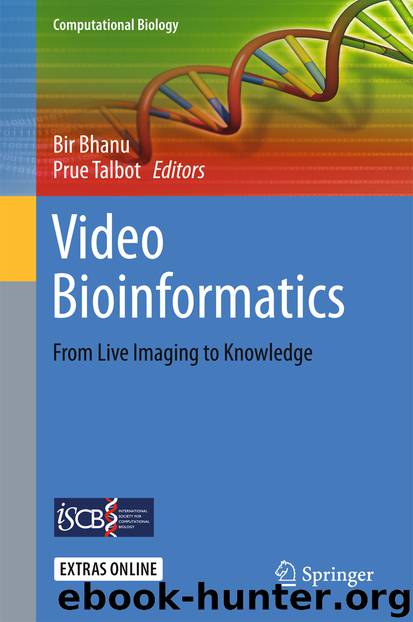Video Bioinformatics by Bir Bhanu & Prue Talbot

Author:Bir Bhanu & Prue Talbot
Language: eng
Format: epub
Publisher: Springer International Publishing, Cham
9.1 Introduction
Evaluation of dynamic cell processes and behavior is important in basic research [11, 40, 43, 46], in the application of stem cell biology to regenerative medicine [29, 41], and in studies involving the toxicity of drug candidates and environmental chemicals [13, 24, 25, 31, 32, 35–38, 42]. Prior work in basic and toxicological research has often involved microscopic observation of cells or assays that evaluate single endpoints after chemical exposure (e.g., [4, 6–8, 25, 33]). However, much additional insight can be learned about a cells response to its environment by comparing dynamic processes, such as cell growth and motility, in treated and control cells [30, 31, 44]. Just as human body language can reveal information about human mood and well-being, cellular dynamics can often reveal information about the mode of action and the cellular targets of chemical exposure. For example, impairment of cell motility would likely be correlated with an adverse effect on the cytoskeleton . Such an effect can be quantified in video data without using any labels or genetic transformation of the cells [25, 31, 36, 49]. In addition, fluorescent labels can be used to report the condition of cells in time-lapse data thereby revealing more information about a treatment than a single endpoint assay [27]. Finally, multiple endpoints can be multiplexed and mined from video data to gain additional insight from a single experiment [2, 34].
The interest and importance of video data in cellular studies has led to the commercialization of a number of instruments (e.g., BioStation CT/IM , Cell IQ, Tokai Hit) optimized for collecting live cell images over time [10, 44]. Videos can now be made for hours, days, or even months using conditions that support in vitro cell culture and experimentation. However, while dynamic video data are rich with information about cell health and cell processes, they are often difficult to analyze quantitatively. This is due to the complexity of the data and the generally large size of the data sets. Moreover, video analysis can be very time-consuming and is error-prone due to subjectivity of the human(s) performing the analysis. The recent interest in live cell imaging has been accompanied by a need for software tools for extracting information from video data. This field of study has been termed “video bioinformatics ” (http://www.cris.ucr.edu/IGERT/index.php). Video bioinformatics includes the development and application of software tools for extraction and mining of information and knowledge from video data. The advantages of using video bioinformatics tools are enormous. Tremendous amounts of time can be saved, and when properly applied, video bioinformatics tools will extract more accurate reproducible data than would generally be the case for a human performing the same task. Video bioinformatics tools are available commercially [3] and are also being developed in research laboratories to solve specific problems such as quantification of cells in colonies, cell identification, and prediction of successful development of human embryos to the blastocyst stage [14–17, 21, 51].
In this chapter, four applications of video bioinformatics tools to toxicological problems are presented. First, cell colony and individual cell growth were monitored using time-lapse data .
Download
This site does not store any files on its server. We only index and link to content provided by other sites. Please contact the content providers to delete copyright contents if any and email us, we'll remove relevant links or contents immediately.
Algorithms of the Intelligent Web by Haralambos Marmanis;Dmitry Babenko(16237)
Jquery UI in Action : Master the concepts Of Jquery UI: A Step By Step Approach by ANMOL GOYAL(9389)
Test-Driven Development with Java by Alan Mellor(7737)
Data Augmentation with Python by Duc Haba(7610)
Principles of Data Fabric by Sonia Mezzetta(7380)
Learn Blender Simulations the Right Way by Stephen Pearson(7296)
Microservices with Spring Boot 3 and Spring Cloud by Magnus Larsson(7139)
Hadoop in Practice by Alex Holmes(6589)
RPA Solution Architect's Handbook by Sachin Sahgal(6519)
The Infinite Retina by Robert Scoble Irena Cronin(6217)
Big Data Analysis with Python by Ivan Marin(5937)
Life 3.0: Being Human in the Age of Artificial Intelligence by Tegmark Max(5518)
Pretrain Vision and Large Language Models in Python by Emily Webber(4896)
Infrastructure as Code for Beginners by Russ McKendrick(4654)
Functional Programming in JavaScript by Mantyla Dan(4438)
WordPress Plugin Development Cookbook by Yannick Lefebvre(4386)
The Age of Surveillance Capitalism by Shoshana Zuboff(4252)
Embracing Microservices Design by Ovais Mehboob Ahmed Khan Nabil Siddiqui and Timothy Oleson(4149)
Applied Machine Learning for Healthcare and Life Sciences Using AWS by Ujjwal Ratan(4136)
